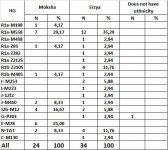This is verry interesting and also can explain resemblance between Moldova and Mordovia.
All my known 160-200+ years ancestors lived in the same small area in southern Romania.
I received a recent DNA result and I was wondering why besides Y - G2a2b2a, I have in the result 2% of Mordovia (the only percentage of NE Europe). But also, I think this can explain NW-Euro percents... Germany+France+Scandinavia 10% + England others 8.7% in addition to 2/3 Balkan.
The name
Mordva is thought to originate from an
Iranian (
Scythian) word
mard meaning "man". The Mordvin word
mirde denoting a husband or spouse is traced to the same origin. This word is also probably related to the final syllable of "
Udmurt", and also in
Komi: mort and perhaps even in
Mari: marij.
[13]
'Erzya' is thought to derive from the
Persian: arshan – man. The first written mention of
Erzya is considered to be in a letter dated to 968 AD by Joseph the
Khazar khaqan in the form of
arisa, and sometimes thought to be in the works of
Strabo and
Ptolemy called as
Aorsy and
Arsiity respectively.
Estakhri from the 10th century has recorded among the three groups of the
Rus people the
al-arsanija whose king lived in the town of
Arsa. The people have sometimes identified by scholars as Erzya, sometimes as the
aru people and also as
Udmurts. It has been suggested by historians that the town
Arsa may refer to either the modern
Ryazan or
Arsk[10] In the 14th century the name Erzya is considered to be mentioned in the form of
ardzhani by
Rashid-al-Din Hamadani,
[14] and as
rzjan by Jusuf, the Nogaj khan
[15] In Russian sources the ethnonym Erza first appears in the 18th century.
[16]
'Moksha' is thought to derive from the name of the
Moksha River (an Iranian hydronym in origin, cognate to
Sanskrit:
moksha "releasing, causing to flow").
[17] The earliest written mention of Moksha in the form of Moxel is considered to be in the works of a 13th-century Flemish traveler
William of Rubruck and in the Persian chronicle
Rashid-al-Din who reported the
Golden Horde being in war with the Moksha and the Ardzhans (Erzia). In Russian sources 'Moksha' appears from the 17th century.
[18]
https://en.wikipedia.org/wiki/Mordvins
The name "Moldova" derives from the
Moldova River; the valley of this river served as a political centre at the time of the
foundation of the
Principality of Moldavia in 1359.
[20] The origin of the name of the river remains unclear. According to a legend recounted by Moldavian chroniclers
Dimitrie Cantemir and
Grigore Ureche, Prince
Dragoș named the river after hunting an
aurochs: following the chase, the prince's exhausted hound
Molda drowned in the river. The dog's name, given to the river, extended to the Principality.
[21]
For a short time in the 1990s, at the founding of the
Commonwealth of Independent States, the name of the current Republic of Moldova was also spelled "Moldavia".
[22] After the
dissolution of the Soviet Union, the country began to use the Romanian name,
Moldova. Officially, the name
Republic of Moldova is designated by the
United Nations.
https://en.wikipedia.org/wiki/Moldova
Both the Czech name
Vltava and the German name
Moldau are believed to originate from the
old Germanic words
*wilt ahwa ("wild water"; compare
Latin aqua).
[6] In
Annales Fuldenses (872 AD) it is called
Fuldaha; from 1113 AD it is attested as
Wultha. In
Chronica Boemorum (1125 AD) it is attested for the first time in its
Bohemian form as
Wlitaua.
[3]
On the other side there is a river
Ltava in Ukraine with no traces of Germanic origins. The name of a settlement on this river was mentioned in the
Hypatian Chronicle in 1174, traditionally connected to the name of the city of
Poltava,
Ukraine. There are many theories describing etymology of
Ltava.
[7]
https://en.wikipedia.org/wiki/Vltava

